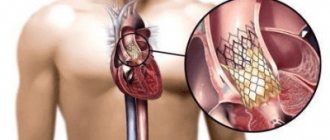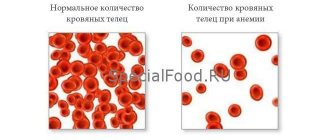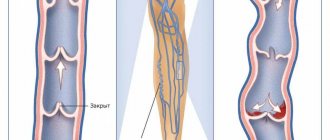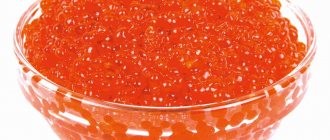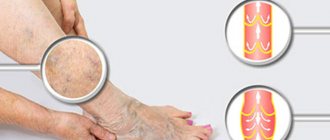Why is diet so important for varicose veins?
By following a diet, you can restore normal blood flow, reduce the load on damaged vessels, and cleanse the body of accumulated toxins. It must be observed in any case of varicose veins, regardless of whether it concerns only the legs or affects the pelvic organs. The diet is used at the first signs of a pathological condition of blood vessels as a preventive measure, and when surgery is prescribed - as an important component of pre- and postoperative therapy.
In order to properly develop a dietary regimen, the doctor takes into account various characteristics of the patient’s body: his age, weight, hereditary diseases, allergic sensitivity, health status, as well as the specifics of his lifestyle. However, any diet for varicose veins is based on general principles that allow you to avoid relapses and complications of the disease.
Reviews and results
- “... After the second birth, my problems with the veins of my legs began. At first small bumps appeared, and then pain. Now we have a complete picture of legs disfigured by varicose veins. The phlebologist suggests laser surgery, but I’m hesitant about it yet. I take all the medications prescribed by the doctor, wear compression stockings, low-heeled shoes, and go on a diet as recommended by the doctor. I just don't know if this will help or not. I wouldn’t like to undergo surgery”;
- “... I have been suffering from varicose veins on my legs for almost 10 years. Varicose veins appeared after hard work in a mine. I have already tried almost all ointments, physiotherapy, special stockings and of course medications. I try to eat right, quit smoking and drinking alcohol. So far we have managed to avoid surgery.”
Diet goals for varicose veins
The list of goals that the doctor and patient sets for themselves when prescribing a diet includes:
- Reduce blood viscosity to improve its trophic properties and lower blood pressure.
- Strengthen blood vessels to prevent the worsening of varicose veins and create the prerequisites for its successful treatment.
- Relieve swelling, but at the same time provide the body with the fluid it needs.
- Getting rid of excess weight, in the presence of which it is almost pointless to fight varicose veins.
Diet for varicose veins of the esophagus
Varicose veins of the esophagus occur due to a violation of the outflow of blood from the venous vessels of the esophagus through the portal and superior vena cava system. This venous disease is typical for patients of any age.
!
At the same time, the incidence of the disease in men is twice as high as in women; this is mainly due to excessive consumption of alcohol-containing drinks.
The diet for esophageal vein disease comes down to excluding a number of foods from the menu. Their list is given above. It can only be supplemented with a product such as sugar, the use of which will also have to be abandoned.
It is also important to eat large portions; the longer the gap between meals, the better. In no case should you neglect breakfast. In the morning, you should give preference to fatty foods: omelet, scrambled eggs, cod liver.
What products will be useful in the treatment of varicose veins?
Despite the limitations, the correct approach to organizing a diet for varicose veins allows you to provide the body with all the necessary substances. Thus, following the diet rules does not lead to any gastrointestinal problems.
- Products with plant fiber. They are carbohydrates that are broken down gradually and without fat deposition. When consuming fiber, there are no spikes in insulin levels, energy is released slowly and continuously;
- Water - drink about 2-2.5 liters per day, pure and in juices, tea, etc.;
- Dried fruits - can thin the blood and replace sweets in the diet;
- Spices – curry, thyme, turmeric, ginger. In addition to taste, they contain unique active plant substances that improve blood properties.
- Legumes and nuts are rich in tocopherol (vitamin E) and easily digestible plant proteins.
- Algae - contain minerals necessary to strengthen blood vessels.
- Berries and fruits are sources of vitamin C; some (raspberries, cherries) can increase hemoglobin levels, which is useful for cellular respiration.
- Seafood is one of the few sources of omega-3 unsaturated fats, which promote the resorption of cholesterol plaques and are necessary for maintaining a healthy immune system.
- Sprouted wheat is a useful product for cleansing the body, rich in amino acids, fatty acids and vitamins.
Authorized Products
The diet of a patient with varicose veins should include lean poultry (turkey, chicken), rabbit, lean beef, and beef liver.
All types of seafood (mussels, squid, crabs, oysters, shrimp) and fish, seaweed and other seaweed are extremely healthy.
The diet includes foods rich in unsaturated fatty acids - vegetable oils, nuts, flax seeds, cauliflower.
Vegetables and fruits are especially useful - bell peppers, tomatoes, carrots, zucchini, potatoes, garden herbs, sauerkraut, which can be consumed in various forms, both separately and in salads, as well as berries and fruits - apples, apricots, citrus fruits, cherry, black currant.
It is useful to include various grains in the diet, both in the form of porridges and breads.
Low-fat cottage cheese and fermented milk products are recommended for dairy products.
The bread is whole grain.
To saturate the body with fluid, it is recommended to drink mineral still water, juices, green, fruit or herbal tea, fruit drinks, jelly, and compotes.
Table of permitted products
| Proteins, g | Fats, g | Carbohydrates, g | Calories, kcal | |
Vegetables and greens | ||||
| boiled cauliflower | 1,8 | 0,3 | 4,0 | 29 |
| canned grape leaves | 4,3 | 2,0 | 11,7 | 69 |
| carrot | 1,3 | 0,1 | 6,9 | 32 |
| cucumbers | 0,8 | 0,1 | 2,8 | 15 |
| salad pepper | 1,3 | 0,0 | 5,3 | 27 |
| boiled beets | 1,8 | 0,0 | 10,8 | 49 |
| tomatoes | 0,6 | 0,2 | 4,2 | 20 |
| dill | 2,5 | 0,5 | 6,3 | 38 |
| garlic | 6,5 | 0,5 | 29,9 | 143 |
Fruits | ||||
| apricots | 0,9 | 0,1 | 10,8 | 41 |
| oranges | 0,9 | 0,2 | 8,1 | 36 |
| cherry | 0,8 | 0,5 | 11,3 | 52 |
| grapefruit | 0,7 | 0,2 | 6,5 | 29 |
Berries | ||||
| cranberry | 0,5 | 0,0 | 6,8 | 26 |
| gooseberry | 0,7 | 0,2 | 12,0 | 43 |
| Rowan | 1,5 | 0,1 | 10,9 | 50 |
| currant | 1,0 | 0,4 | 7,5 | 43 |
| rose hip | 1,6 | 0,0 | 14,0 | 51 |
Nuts and dried fruits | ||||
| dried apricots | 5,2 | 0,3 | 51,0 | 215 |
| prunes | 2,3 | 0,7 | 57,5 | 231 |
Cereals and porridges | ||||
| buckwheat (kernel) | 12,6 | 3,3 | 62,1 | 313 |
| cereals | 11,9 | 7,2 | 69,3 | 366 |
| Wheat groats | 11,5 | 1,3 | 62,0 | 316 |
Bakery products | ||||
| whole grain bread | 10,1 | 2,3 | 57,1 | 295 |
Confectionery | ||||
| jam | 0,3 | 0,1 | 56,0 | 238 |
Raw materials and seasonings | ||||
| honey | 0,8 | 0,0 | 81,5 | 329 |
Dairy | ||||
| kefir 3.2% | 2,8 | 3,2 | 4,1 | 56 |
| sour cream 15% (low fat) | 2,6 | 15,0 | 3,0 | 158 |
Cheeses and cottage cheese | ||||
| cottage cheese | 17,2 | 5,0 | 1,8 | 121 |
Meat products | ||||
| lean pork | 16,4 | 27,8 | 0,0 | 316 |
| beef | 18,9 | 19,4 | 0,0 | 187 |
| beef liver | 17,4 | 3,1 | 0,0 | 98 |
| calf liver | 19,2 | 3,3 | 4,1 | 124 |
| mutton | 15,6 | 16,3 | 0,0 | 209 |
| rabbit | 21,0 | 8,0 | 0,0 | 156 |
| beef stew | 14,1 | 17,4 | 0,0 | 214 |
Bird | ||||
| chicken liver | 20,4 | 5,9 | 1,4 | 140 |
| turkey | 19,2 | 0,7 | 0,0 | 84 |
| turkey liver | 19,5 | 22,0 | 0,0 | 276 |
| goose liver | 15,2 | 39,0 | 0,0 | 412 |
Eggs | ||||
| chicken eggs | 12,7 | 10,9 | 0,7 | 157 |
Fish and seafood | ||||
| brown algae | 1,7 | 0,6 | 8,3 | 43 |
| pink salmon | 20,5 | 6,5 | 0,0 | 142 |
| Red caviar | 32,0 | 15,0 | 0,0 | 263 |
| cod roe | 24,0 | 0,2 | 0,0 | 115 |
| pike caviar | 17,3 | 2,0 | 0,0 | 87 |
| squid | 21,2 | 2,8 | 2,0 | 122 |
| shrimps | 22,0 | 1,0 | 0,0 | 97 |
| salmon | 19,8 | 6,3 | 0,0 | 142 |
| mussels | 9,1 | 1,5 | 0,0 | 50 |
| seaweed | 0,8 | 5,1 | 0,0 | 49 |
| herring | 16,3 | 10,7 | — | 161 |
| cod (liver in oil) | 4,2 | 65,7 | 1,2 | 613 |
| trout | 19,2 | 2,1 | — | 97 |
Oils and fats | ||||
| vegetable oil | 0,0 | 99,0 | 0,0 | 899 |
| butter | 0,5 | 82,5 | 0,8 | 748 |
| olive oil | 0,0 | 99,8 | 0,0 | 898 |
| * data is per 100 g of product |
What foods should be excluded from the diet for varicose veins?
Some foods negatively affect the composition of the blood, which invariably affects blood vessels. Those prone to varicose veins can suffer significantly from their use.
Therefore, they are strictly prohibited, especially in severe forms of the disease.
- Alcohol.
- Fat-rich foods.
- Sugar and other light carbohydrates.
- Black tea and coffee
- Canned food
- Meat broths
- Smoked products.
As you can see, the list of prohibited products is much shorter than the recommended ones. Even if you have to give up especially favorite treats, you can replace them with new ones that are beneficial for the body. Improving your health and eliminating the symptoms of varicose veins will give you lightness and pleasure that exceeds the usual effect of sweets, smoked foods, alcohol and any other product harmful to varicose veins.
General rules
Varicose veins (VVEs) are based on valvular insufficiency of the peripheral superficial or deep veins. The term “varicose veins” is associated, as a rule, with pathological changes in the veins of the lower extremities of the veins, although the problem of varicose veins is much wider and there are other types of disease - varicose veins of the esophagus ( phlebectasia ), varicose veins of the rectum ( hemorrhoids ), pelvic varicose veins (varicose veins of the small pelvis), varicose veins of the female genital organs, varicocele (dilation of the veins of the spermatic cord).
In the complex treatment of varicose veins, especially in the early stages of the disease, conservative therapy, including medication, special exercises, massage and diet, becomes more important. As such, there is no standardized diet for venous insufficiency and diet is not used as an independent measure in the treatment of varicose veins, but as an auxiliary method, diet in combination with other measures gives a good effect and allows you to stop the progression of the disease. The diet for varicose veins in the legs should be aimed at:
- normalization of body weight;
- strengthening the walls of venous vessels;
- reducing blood viscosity to lower blood pressure and improve its trophic properties;
- Relieving swelling while meeting the body's fluid needs.
The diet for varicose veins of the legs is based on the principles of rational nutrition and does not provide for any strict restrictions. If the patient has increased body weight, then in such cases dietary nutrition should be aimed primarily at normalizing weight, since “extra pounds” place an increased load on the venous system of the lower extremities. For this purpose, a physiologically complete diet with a reduced calorie content (2300-2400 Kcal) is prescribed if the weight is slightly higher than normal or Dietary Table No. 8 according to Pevzner in the presence of obesity (1600-1700 Kcal).
The energy value of the diet is reduced due to easily digestible fats (mainly animal fats) and carbohydrates, with a physiologically normal protein content. Limits on fatty varieties of red meat, boiled and smoked sausages, goose meat, duck meat, canned meat, ham, cooking and animal fat, baked goods, confectionery products, mayonnaise, as well as heavy cream, cottage cheese, baked milk, sweet cheesecakes and yogurt, salty and fatty cheeses, fried chicken eggs, semolina and oatmeal, pasta, legumes, rice. Table salt, foods and dishes that stimulate the appetite, strong meat broths and free liquid are subject to restrictions.
At normal weight, the basis of the diet should be whole grains, vegetables, and fruits. They contain a fairly large amount of fiber, from which fibrous fibers are synthesized that strengthen the walls of the veins. In the diet, the consumption of fatty and fried foods, spicy and salty foods is limited, since the thirst they provoke causes excessive fluid intake, which causes an increase in blood volume and, accordingly, overload of the venous system. In addition, smoked, fried and spicy foods in large quantities negatively affect the rheological properties of blood (increase its viscosity), thereby increasing the risk of blood clots . In addition, food rich in cholesterol contributes to the development of atherosclerosis with the formation of atherosclerotic deposits on the walls of blood vessels and narrowing of their lumen.
Bell peppers, cabbage of various types, carrots, tomatoes, seasoned with any vegetable oil with the addition of garden herbs, saturate the body with vitamins and microelements, help improve elasticity and strengthen the walls of blood vessels. Jacket potatoes, sprouted grains of rye, oats, wheat, garlic, as well as black currants, gooseberries, rose hips and strawberries have a similar effect. The diet should include various porridges, beef liver, seaweed, nuts and dried fruits, rye bread, garlic, herbal infusions and green tea.
In order to strengthen the vascular endothelium of the leg veins and improve blood circulation, the diet should include foods containing organic flavonoids and antioxidants , which can prevent damage to the walls of venous vessels and increase their impermeability to fluid. Large amounts of these substances are found in berries, citrus fruits, apples, large-leaf green tea, as well as freshly squeezed juice from natural berries, fruits and vegetables. They are especially rich in rutin ( vitamin P ), which effectively reduces capillary fragility.
Flavonoids also reduce pain by blocking leukocyte aggression (inhibiting the process of adhesion and migration of neutrophil leukocytes ). Biologically active flavonoids ( isoquercetin and quercetin glucuronide ) contained in red grape leaves, as well as saponins contained in horse chestnut, have pronounced capillary-protective and anti-edematous effects. Dishes from these plants must be present in the diet - in the form of dolma, baked chestnuts.
It is recommended to limit the consumption of meat, replacing it with seafood (squid, crabs, mussels, shrimp, oysters) and fish. These products, along with beef liver, contain a lot of copper, which activates enzymes involved in the synthesis of an important component of the venous wall - elastin.
A prerequisite for proper nutrition for varicose veins of the lower extremities is limiting salt, which contributes to fluid retention in the body and limiting fluid intake (in the presence of edema ). It is the correctly selected drinking regime that serves to prevent blood clots. To increase efficiency, especially if you are overweight, you can arrange fasting days once every 2 weeks.
It is also recommended to include foods rich in magnesium in the menu, since a decrease in magnesium ions and an accumulation of calcium ions causes spasm of smooth muscle fibers and the appearance of cramps and pain. Foods high in magnesium include sesame seeds, pumpkin seeds, spinach, pine nuts, and wheat bran.
Long-term disruption of venous outflow often provokes the formation of blood clots in deep ( thrombosis ) or varicose veins affected by the saphenous veins ( thromphlebitis ). The diet for varicose veins and thrombophlebitis is not fundamentally different, however, it is additionally necessary to exclude from the diet foods containing vitamin K , which is an active component of the blood clotting process - beef/pork liver, spinach, beans, celery, cauliflower, watercress, kale , broccoli, seaweed. If you have already developed thrombophlebitis, it is recommended to include a mixture of garlic, onions, lemons and honey in your diet (100 g honey, 200 g onions, 50 g lemon, 100 g garlic) and take 1 tsp. 3 times a day. It is also recommended to take additional vitamins A , E , P and the vitamin preparation Ascorutin , dietary supplement Hawthorn forte .
Nutrition secrets
For many people, just the word “diet” implies strict restrictions and an ordeal of willpower in an attempt to do without their favorite foods. But those who tried the diet for varicose veins discovered many new and varied dishes with excellent taste.
To improve the taste, benefits and balance of dietary dishes, try following these tips:
- Combine salads made from foods rich in retinol and beta-carotins with vegetable oil. These vitamins are fat-soluble and are much better absorbed dissolved in oil.
- Okroshka and green soups (cabbage soup) are both nutritious, thirst-quenching and cooling dishes, indispensable in the hot season.
- Add a product such as beef liver to your diet. The liver makes an excellent pate if you boil it with vegetables and grind it in a meat grinder with spices and vegetable oil.
- Try to eat a variety of cereals every day. Any well-cooked porridge is perfectly absorbed by the digestive system, has a beneficial effect on intestinal function, satisfies hunger and the body’s need for complex carbohydrates.
- Do not overeat, as acetylcholine receptors, which transmit the feeling of hunger, are saturated in about half an hour. Stop eating before you feel full - your body will feel satisfied later.
- Try a wide variety of herbal teas. You can brew the leaves and flowers of many plants: linden, mint, lemon balm, thyme, raspberry, etc. Each of them has its own unique taste and beneficial properties. If you have the opportunity to grow raw materials for tea in your own flowerbed or go to ecologically clean forests and plantings to get it, then you can be absolutely sure of their benefits.
Nutritional Features
The basic principles of nutrition for varicose veins are as follows:
- Diet for arthritis of the fingers - a complete menu for the week with photos
- products that can retain water in the body, causing tissue pastiness and extra pounds (sweets, baked goods, pickles, smoked meats, marinades, fast food) are excluded;
- support for normal liver function is ensured, for which fatty, fried and spicy foods and canned food are removed from the diet. artificial colors;
- to prevent blood viscosity, fresh fruits, vegetables, sprouted grains, cereals, low-fat milk derivatives, berries, and herbs are added to the daily menu;
- Weekly fasting days are organized based on monoproducts - kefir, apple, rice;
- the drinking ration is calculated per kilogram of the patient’s weight (4 ml per kilogram), thick blood slows down the blood flow, promotes stagnation in the capillaries, so it is difficult for the myocardium to pump it, lift it up, which provokes varicose veins;
- the principle of nutrition is fractional (every 2-3 hours), portions are the size of a palm, the last meal is three hours before bedtime, all this speeds up metabolism and helps normalize blood flow;
- food is steamed or boiled, baked, stewed;
- it is necessary to completely give up smoking and alcohol, which provokes blood clots due to the action of toxins on blood vessels and blood components;
- instead of strong tea, coffee, sweet soda, use herbal teas, compotes, fruit drinks, which saturate the body with minerals and vitamins;
- The total calorie content of the diet, without gender differences, for varicose veins is 30 kcal per kilogram of weight. If there is a need to lose extra pounds, then for women – 1,200 kcal, for men – 1,500 kcal.
Diet for varicose veins
The nutritional rules provided for by the diet include not only recommendations and prohibitions on certain foods, but also ways of consuming them. The list of basic rules of diet for varicose veins is small, but each of them should be strictly adhered to.
- Don't forget about breakfast. Every morning, the body should receive approximately half of all carbohydrates and proteins for the day, so a sandwich with coffee is not considered a complete breakfast. Prepare a normal meal, and if you have no appetite, try waking up half an hour earlier.
- Eat small and often. Divide the usual three meals a day into at least 5 meals in order to evenly load the digestive and circulatory system.
- Don't eat before bed. No food after 18 hours, and especially before bedtime. In addition, you will immediately feel the desire to have breakfast.
- You should not drink while eating. Do not wash down food with water, so as not to dilute gastric juice.
Buckwheat and its beneficial properties
Buckwheat contains:
- amino acids: lysine and arginine, necessary for the functioning of the heart and blood vessels,
- proteins that are easily digestible by the human body,
- tryptophan, which ensures sound healthy sleep and also helps fight depression,
- magnesium, necessary for stimulating the muscle tissue of organs and the functioning of various types of enzymes,
- fiber, which can improve intestinal activity,
- iron.
Read also: Prevention and treatment of reticular varicose veins
As for rutin, per 100 g of buckwheat there is 0.48 mg of rutin, which can help with varicose veins.
Drinking for varicose veins
If you follow the rules of the diet, the body gradually begins to cleanse itself. To ensure this process, it is necessary to increase the consumption of water necessary for the operation of the excretory system.
During the diet, pay special attention to the quality of water consumed. Tap water purified by boiling is too hard - this can be easily checked by observing the appearance of scale on the inside surface of the kettle. It is difficult to cleanse the body with such water, so you will have to purchase specially purified or mineral water, or collect it from proven sources (spring, well, etc.)
Drinking high-quality water will have a beneficial effect on the functioning of the gastrointestinal tract, the condition of the skin, hair and nails, and will also improve blood composition and overall well-being.
Example of a diet menu for varicose veins
Many patients find it difficult to follow all the rules of diets because they do not create their own nutrition plan. There are not so many foods that are prohibited for varicose veins, so this plan is quite simple to draw up. Every day you can change the products you use to ones of similar composition to diversify the menu.
For example, we offer several dietary menu options for varicose veins:
- First option:
- First meal at 7 am: breakfast consisting of vegetable salad with porridge.
- Second - at 10 am: raisins (50-100 g) with herbal tea.
- The third is lunch, at about one o'clock in the afternoon: for the first course, soup in chicken broth with green peas, for the second - boiled fillet of sea or red fish with vegetables.
- Fourth – dinner, at four o’clock in the afternoon: salad with seaweed.
- Fifth meal - second dinner, at six o'clock in the evening: low-fat yogurt with fruit salad.
- Second option:
- Breakfast: cheese with tomato on black bread, washed down with ginger tea.
- Afternoon snack: yogurt with berries.
- Lunch: pumpkin soup, baked fish with mashed potatoes.
- Dinner: steamed red fish with green vegetable salad.
- Second dinner: natural apple and carrot juice with pulp.
- Third option:
- Breakfast: cottage cheese with nuts and dried fruits, bread and natural fruit juice.
- Afternoon snack: apple baked in honey with nuts.
- Lunch: lentil soup, porridge with steamed meatballs.
- Dinner: boiled chicken or turkey breast, rye bread and compote.
- Second dinner: grain bread with tomato juice.
Fully or partially limited products
Strong meat broths, fatty varieties of red meat, goose meat, duck meat, boiled and smoked sausages, canned meat, bacon, ham, cooking and animal fat, mayonnaise, baked goods, confectionery, as well as heavy cream, cottage cheese, sweets are excluded from the diet. cheesecakes and yogurt, baked milk, fried chicken eggs, salty and fatty cheeses, semolina and oatmeal, pasta, legumes, white rice.
Table salt and salty foods, dishes, spices and seasonings that stimulate the appetite are subject to restrictions.
Limit the consumption of coffee and black tea.
The consumption of smoked meats, marinades, and alcohol-containing drinks is not allowed.
Table of prohibited products
| Proteins, g | Fats, g | Carbohydrates, g | Calories, kcal | |
Cereals and porridges | ||||
| wheat bran | 15,1 | 3,8 | 53,6 | 296 |
Confectionery | ||||
| cake | 3,8 | 22,6 | 47,0 | 397 |
Cakes | ||||
| cake | 4,4 | 23,4 | 45,2 | 407 |
Chocolate | ||||
| chocolate | 5,4 | 35,3 | 56,5 | 544 |
Raw materials and seasonings | ||||
| mayonnaise | 2,4 | 67,0 | 3,9 | 627 |
Dairy | ||||
| milk | 3,2 | 3,6 | 4,8 | 64 |
| cream 35% (fat) | 2,5 | 35,0 | 3,0 | 337 |
| sour cream 30% | 2,4 | 30,0 | 3,1 | 294 |
Cheeses and cottage cheese | ||||
| cheese | 24,1 | 29,5 | 0,3 | 363 |
Meat products | ||||
| fried pork | 11,4 | 49,3 | 0,0 | 489 |
| pork fat | 1,4 | 92,8 | 0,0 | 841 |
| bacon | 23,0 | 45,0 | 0,0 | 500 |
Sausages | ||||
| smoked sausage | 28,2 | 27,5 | 0,0 | 360 |
Bird | ||||
| duck | 16,5 | 61,2 | 0,0 | 346 |
| goose | 16,1 | 33,3 | 0,0 | 364 |
Fish and seafood | ||||
| fried fish | 19,5 | 11,7 | 6,2 | 206 |
Oils and fats | ||||
| cooking fat | 0,0 | 99,7 | 0,0 | 897 |
| rendered pork fat | 0,0 | 99,6 | 0,0 | 896 |
Alcoholic drinks | ||||
| white dessert wine 16% | 0,5 | 0,0 | 16,0 | 153 |
| vodka | 0,0 | 0,0 | 0,1 | 235 |
| cognac | 0,0 | 0,0 | 0,1 | 239 |
| liquor | 0,3 | 1,1 | 17,2 | 242 |
| beer | 0,3 | 0,0 | 4,6 | 42 |
Non-alcoholic drinks | ||||
| cola | 0,0 | 0,0 | 10,4 | 42 |
| coffee | 0,2 | 0,0 | 0,3 | 2 |
| Pepsi | 0,0 | 0,0 | 8,7 | 38 |
| black tea | 20,0 | 5,1 | 6,9 | 152 |
| energy drink | 0,0 | 0,0 | 11,3 | 45 |
| * data is per 100 g of product | ||||
Colored diet
One of the modern fashion trends in nutrition is the colored diet. It is based on daily changing the diet of plant foods based on their color. The theoretical justification for this diet is that the colors of vegetables and fruits mean the presence of certain beneficial substances necessary for blood vessels. Eating foods of the same color every day is more convenient for the digestive system, which specifically secretes enzymes for the complete absorption of complex substances of the same type.
For example, fruits acquire yellow and orange shades thanks to beta-carotenes - a whole family of pigments and B vitamins. Blue and purple colors are due to the high content of fucoxanthins. Greens rich in chlorophyll are known for their high concentration of micronutrients such as calcium, magnesium, potassium, etc. Red berries, fruits and vegetables contain the most vitamin C.
The effectiveness of the colored diet has been confirmed in practice, due to which it is constantly recommended by many nutritionists as the most rational way to saturate the body with vitamins and minerals of plant origin.
Author of the article:
Kuzmina Vera Valerievna |
Endocrinologist, nutritionist Education: Diploma of the Russian State Medical University named after. N.I. Pirogov, specialty “General Medicine” (2004). Residency at the Moscow State Medical and Dental University, diploma in Endocrinology (2006). Our authors
Vitamins and microelements
The basis of vascular elasticity is the balance of vitamins and minerals in the human body, which regulate metabolic and redox processes. Diseased blood vessels desperately need these substances. They can be found in the following products:
| Useful material | Where are they kept? |
| Vegetable fiber | Vegetables, fruits, grains, bran |
| Vitamin C | Cranberries, citrus fruits, currants, gooseberries, greens, spinach |
| Vitamin P | Apples, tomatoes, greens, cherries |
| B vitamins | Cereals, eggs, meat, milk, cheese, fish, nettles |
| Vitamin A | Carrots, mint, red bell peppers, peaches |
| Vitamin E | Sprouted wheat, vegetable oils, nuts, eggs, caviar, corn |
| Bioflavonoids | Green tea, berries |
| Calcium | Savoy cabbage, parsley, sesame, beans, soybeans |
| Potassium | Cocoa, dried fruits, nuts, mushrooms |
| Zinc | Egg yolk, pine nuts, beef liver, soy, potato, radish |
| Omega 3 fatty acids | Seafood, olive oil, sea fish |
| Silicon | Beans, cereals, soybeans, grapes |
| Copper | Seafood, seaweed, liver, cocoa |
| Iodine | Seafood |
| Phosphorus | Pumpkin, bran, beans, poppy seeds, cheese |


